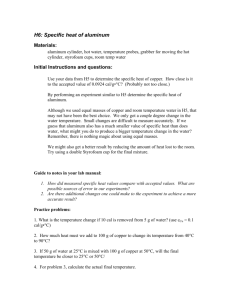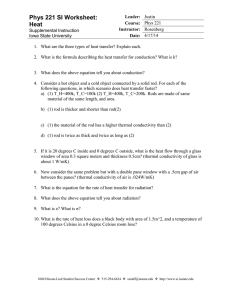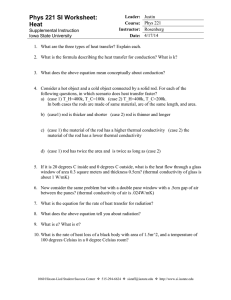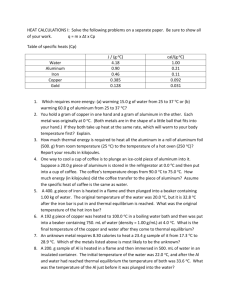Document 10285986
advertisement
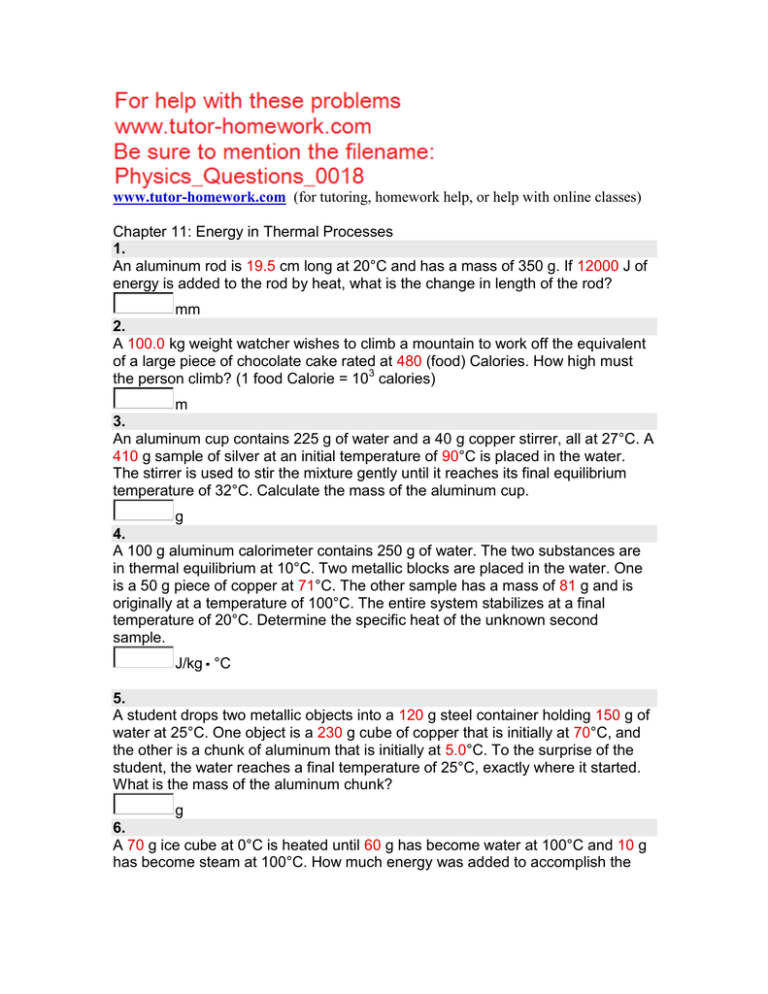
www.tutor-homework.com (for tutoring, homework help, or help with online classes) Chapter 11: Energy in Thermal Processes 1. An aluminum rod is 19.5 cm long at 20°C and has a mass of 350 g. If 12000 J of energy is added to the rod by heat, what is the change in length of the rod? mm 2. A 100.0 kg weight watcher wishes to climb a mountain to work off the equivalent of a large piece of chocolate cake rated at 480 (food) Calories. How high must the person climb? (1 food Calorie = 103 calories) m 3. An aluminum cup contains 225 g of water and a 40 g copper stirrer, all at 27°C. A 410 g sample of silver at an initial temperature of 90°C is placed in the water. The stirrer is used to stir the mixture gently until it reaches its final equilibrium temperature of 32°C. Calculate the mass of the aluminum cup. g 4. A 100 g aluminum calorimeter contains 250 g of water. The two substances are in thermal equilibrium at 10°C. Two metallic blocks are placed in the water. One is a 50 g piece of copper at 71°C. The other sample has a mass of 81 g and is originally at a temperature of 100°C. The entire system stabilizes at a final temperature of 20°C. Determine the specific heat of the unknown second sample. J/kg °C 5. A student drops two metallic objects into a 120 g steel container holding 150 g of water at 25°C. One object is a 230 g cube of copper that is initially at 70°C, and the other is a chunk of aluminum that is initially at 5.0°C. To the surprise of the student, the water reaches a final temperature of 25°C, exactly where it started. What is the mass of the aluminum chunk? g 6. A 70 g ice cube at 0°C is heated until 60 g has become water at 100°C and 10 g has become steam at 100°C. How much energy was added to accomplish the transformation? J 7. How much energy is required to change a 40 g ice cube from ice at -30°C to steam at 140°C? J 8. What mass of steam that is initially at 130°C is needed to warm 290 g of water and its 300 g aluminum container from 20°C to 50°C? g 9. A resting adult of average size converts chemical energy in food into internal energy at the rate of 120 W, called her basal metabolic rate. To stay at a constant temperature, energy must be transferred out of the body at the same rate. Several processes exhaust energy from your body. Usually the most important is thermal conduction into the air in contact with your exposed skin. If you are not wearing a hat, a convection current of warm air rises vertically from your head like a plume from a smokestack. Your body also loses energy by electromagnetic radiation, by your exhaling warm air, and by the evaporation of perspiration. Now consider still another pathway for energy loss: moisture in exhaled breath. Suppose you breathe out 22.0 breaths per minute, each with a volume of 0.600 L. Suppose also that you inhale dry air and exhale air at 37°C containing water vapor with a vapor pressure of 4.00 kPa. The vapor comes from the evaporation of liquid water in your body. Model the water vapor as an ideal gas. Assume its latent heat of evaporation at 37°C is the same as its heat of vaporization at 100°C. Calculate the rate at which you lose energy by exhaling humid air. W 10. A 78 kg cross-country skier glides over snow as in Figure P11.25. The coefficient of friction between skis and snow is 0.30. Assume all the snow beneath his skis is at 0°C and that all the internal energy generated by friction is added to snow, which sticks to his skis until melted. How far would he have to ski to melt 2.0 kg of snow? m Figure P11.25 11. A 60.0 kg runner expends 335 W of power while running a marathon (Fig. P11.28). Assuming that 11.0% of the energy is delivered to the muscle tissue and that the excess energy is primarily removed from the body by sweating, determine the volume of bodily fluid (assume it is water) lost per hour. (At 37.0°C the latent heat of vaporization of water is 2.41 106 J/kg.) cm3 12. (a) Find the rate of energy flow through a copper block of cross-sectional area 15 cm2 and length 5.0 cm when a temperature difference of 20°C is established across the block. J/s (b) Repeat the calculation, assuming that the material is a block of stagnant air with the given dimensions. J/s (c) Repeat the calculation assuming, that the material is a block of wood with the given dimensions. J/s 13. A steam pipe is covered with 1.50 cm thick insulating material with a thermal conductivity of 0.200 cal/cm °C s. How much energy is lost every second when the steam is at 190°C and the surrounding air is at 20.0°C? The pipe has a circumference of 800 cm and a length of 45.0 m. Neglect losses through the ends of the pipe. MW 14. A box with a total surface area of 1.20 m2 and a wall thickness of 4.65 cm is made of an insulating material. A 10.0 W electric heater inside the box maintains the inside temperature at 16.0°C above the outside temperature. Find the thermal conductivity k of the insulating material. W/m K 15. A thermopane window consists of two glass panes, each 0.50 cm thick, with a 1.0 cm thick sealed layer of air in between. If the inside surface temperature is 24.5°C and the outside surface temperature is 0.0°C, determine the rate of energy transfer through 2.0 m2 of the window. Compare your answer with the rate of energy transfer through 2.0 m2 of a single 1.0 cm thick pane of glass. thermopane window J/s single pane window J/s 16. A copper rod and an aluminum rod of equal diameter are joined end to end in good thermal contact. The temperature of the free end of the copper rod is held constant at 100°C, and that of the far end of the aluminum rod is held at 0°C. If the copper rod is 0.43 m long, what must be the length of the aluminum rod so that the temperature at the junction is 50°C? m 17. A Styrofoam box has a surface area of 0.85 m2 and a wall thickness of 2.0 cm. The temperature of the inner surface is 5.0°C, and the outside temperature is 26°C. If it takes 8.6 h for 5.0 kg of ice to melt in the container, determine the thermal conductivity of the Styrofoam. W/m K 18. A sphere that is a perfect blackbody radiator has a radius of 0.050 m and is at 220°C in a room where the temperature is 23°C. Calculate the net rate at which the sphere radiates energy. W 19. The surface temperature of a particular star (similar to the Sun) is about 5700 K. Taking the radius of the star to be 6.96 108 m, calculate the total energy radiated by the star each second. (Assume e = 0.965.) W 20. The bottom of a copper kettle has a 13.0 cm radius and is 2.1 mm thick. The temperature of the outside surface is 102°C, and the water inside the kettle is boiling at 1 atm of pressure. Find the rate at which energy is being transferred through the bottom of the kettle. J/s 21. A water heater is operated by solar power. If the solar collector has an area of 7.20 m2, and the intensity delivered by sunlight is 650 W/m2, how long does it take to increase the temperature of 1.00 m3 of water from 20.0°C to 55.0°C? h 22. A 50 g ice cube floats in 190 g of water in a 100 g copper cup; all are at a temperature of 0°C. A piece of lead at 99°C is dropped into the cup, and the final equilibrium temperature is 12°C. What is the mass of the lead? kg 23. An iron plate is held against an iron wheel so that a sliding frictional force of 52 N acts between the two pieces of metal. The relative speed at which the two surfaces slide over each other is 32 m/s. (a) Calculate the rate at which mechanical energy is converted to internal energy. kW (b) The plate and the wheel have masses of 5.0 kg each, and each receives 50% of the frictional heat. If the system is run as described for 10 s and each object is then allowed to reach a uniform internal temperature, what is the resultant temperature increase? °C 24. For bacteriological testing of water supplies and in medical clinics, samples must routinely be incubated for 24 h at 37°C. A standard constant temperature bath with electric heating and thermostatic control is not suitable in developing nations without continuously operating electric power lines. Peace Corps volunteer and MIT engineer Amy Smith invented a low cost, low maintenance incubator to fill the need. The device consists of a foam-insulated box containing several packets of a waxy material that melts at 37°C, interspersed among tubes, dishes, or bottles containing the test samples and growth medium (food for bacteria). Outside the box, the waxy material is first melted by a stove or solar energy collector. Then it is put into the box to keep the test samples warm as it solidifies. The heat of fusion of the phase-change material is 205 kJ/kg. Model the insulation as a panel with surface area 0.460 m2, thickness 9.20 cm, and conductivity 0.0120 W/m °C. Assume the exterior temperature is 24.0°C for 12.0 h and 18.0°C for 12.0 h. (a) What mass of the waxy material is required to conduct the bacteriological test? kg (b) Explain why your calculation can be done without knowing the mass of the test samples or of the insulation.
